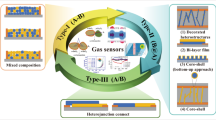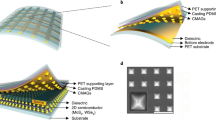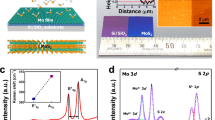Abstract
Research activity in chemical gas sensing is currently directed towards the search for highly selective (bio)chemical layer materials, and to the design of arrays consisting of different partially selective sensors that permit subsequent pattern recognition and multi-component analysis1,2,3. Simultaneous use of various transduction platforms has been demonstrated4,5,6, and the rapid development of integrated-circuit technology has facilitated the fabrication of planar chemical sensors7,8 and sensors based on three-dimensional microelectromechanical systems9,10. Complementary metal-oxide silicon processes have previously been used to develop gas sensors based on metal oxides11 and acoustic-wave-based sensor devices12. Here we combine several of these developments to fabricate a smart single-chip chemical microsensor system that incorporates three different transducers (mass-sensitive, capacitive and calorimetric), all of which rely on sensitive polymeric layers to detect airborne volatile organic compounds. Full integration of the microelectronic and micromechanical components on one chip permits control and monitoring of the sensor functions, and enables on-chip signal amplification and conditioning that notably improves the overall sensor performance. The circuitry also includes analog-to-digital converters, and an on-chip interface to transmit the data to off-chip recording units. We expect that our approach will provide a basis for the further development and optimization of gas microsystems.
This is a preview of subscription content, access via your institution
Access options
Subscribe to this journal
Receive 51 print issues and online access
$199.00 per year
only $3.90 per issue
Buy this article
- Purchase on Springer Link
- Instant access to full article PDF
Prices may be subject to local taxes which are calculated during checkout




Similar content being viewed by others
References
Massart, D. L., Vandeginste, B. G. M., Deming, S. N., Michotte, Y. & Kaufman, L. Chemometrics: a Textbook Vol. 2 (Data Handling in Science and Technology, Elsevier, Amsterdam, 1988).
Brereton, R. G. (ed.) Multivariate Pattern Recognition in Chemometrics Vol. 9 (Data Handling in Science and Technology, Elsevier, Amsterdam, 1992).
Hierlemann, A. et al. in Sensors Update Vol. 2 (eds Baltes, H., Göpel, W. & Hesse, J.) 119–180 (VCH, Weinheim, 1996).
Snow, A. W., Barger, W. R., Klusty, M., Wohltjen, H. & Jarvis, N. L. Simultaneous electrical-conductivity and piezoelectric mass measurements on iodine-doped phthalocyanine Langmuir-Blodgett films. Langmuir 2(4), 513–519 (1986).
Rodriguez, J. L., Hughes, R. C., Corbett, W. T. & McWhorter, P. J. in Technical Digest IEEE International Electron Devices Meeting 521–524 (IEEE, New York, 1992).
Gumbrecht, W. et al. Integrated pO2, pCO2, pH sensor system for online blood monitoring. Sensors Actuators B 18–19, 704–708 (1994).
Van den Berg, A., van der Waal, P. D., van der Schoot, B. B. & de Rooij, N. F. Silicon-based chemical sensors and chemical analysis systems. Sensors Materials 6, 23–43 (1994).
Müller, G., Deimel, P. P., Hellmich, W. & Wagner, C. Sensor fabrication using thin-film-on-silicon approaches. Thin Solid Films 296, 157–163 (1997).
Kovacs, G. T. A. Micromachined Transducers (WCB McGraw-Hill, Boston, 1998).
Madou, M. Fundamentals of Microfabrication (CRC, Boca Raton, Florida, 1997).
Suehle, J. S., Cavicchi, R. E., Gaitan, M. & Semancik, S. Tin oxide gas sensor fabricated using CMOS micro-hotplates and in-situ processing. IEEE Electron Device Lett. 14, 118–120 (1993).
Vellekoop, M. J., Lubking, G. W., Sarro, P. M. & Venema, A. Integrated-circuit-compatible design and technology of acoustic-wave-based microsensors. Sens. Actuators A 44, 249–263 (1994).
Hierlemann, A., Ricco, A. J., Bodenhöfer, K., Dominik, A. & Göpel, W. Conferring selectivity to chemical sensors via polymer side-chain selection: Thermodynamics of vapor sorption by a set of polysiloxanes on thickness-shear mode resonators. Anal. Chem. 72, 3696–3708 (2000).
Koll, A., Kummer, A., Brand, O. & Baltes, H. Discrimination of volatile organic compounds using CMOS capacitive chemical microsensors with thickness-adjusted polymer coating. Proc. SPIE Smart Struct. Mater. 3673, 308–317 (1999).
Steiner, F. P. et al. in Digest 8th Int. Conf. on Solid-state Sensors and Actuators Vol. 2, 814–817 (Foundation for Sensor and Actuator Technology, Stockholm, 1995).
Gimzewski, J. K., Gerber, C., Meyer, E. & Schlittler, R. R. Observation of a chemical reaction using a micromechanical sensor. Chem. Phys. Lett. 217, 589–594 (1994).
Stowe, T. D. et al. Attonewton force detection using ultrathin silicon cantilevers. Appl. Phys. Lett. 71, 288–290 (1997).
Lange, D. et al. in Proc. IEEE Workshop on Micro Electro Mechanical Systems (MEMS 99) 447–452 (IEEE, Piscataway, 1999).
Chen, G. Y., Thundat, T., Wachter, E. A. & Warmack, R. J. Adsorption-induced surface stress and its effects on resonance frequency of microcantilevers. J. Appl. Phys. 77, 3618–3622 (1995).
Thundat, T., Chen, G. Y., Warmack, R. J., Allison, D. P. & Wachter, E. A. Vapor detection using resonating microcantilevers. Anal. Chem. 67, 519–521 (1995).
Lang, H. P. et al. A chemical sensor based on a micromechanical cantilever array for the identification of gases. Appl. Phys. A 66, 61–64 (1998).
Maute, M. et al. Detection of volatile organic compounds with polymer-coated cantilevers. Sensors Actuators B 58, 505–511 (1999).
Hagleitner, C., Lange, D., Brand, O., Hierlemann, A. & Baltes, H. in Digest of Technical Papers IEEE International Solid State Circuits Conf. San Francisco (ed. Wuorinen, J. H.) Vol. 44, 246 (IEEE, Piscataway, 2001).
Bataillard, P., Steffgen, E., Haemmerli, S., Manz, A. & Widmer, H. M. An integrated silicon thermopile as biosensor for the thermal monitoring of glucose, urea and penicillin. Biosensors Bioelectron. 8, 89–98 (1993).
Lerchner, J., Seidel, J., Wolf, G. & Weber, E. Calorimetric detection of organic vapors using inclusion reactions with organic coating materials. Sensors Actuators B 32, 71–75 (1996).
Van Heerwarden, A. W., Sarro, P. M., Gardner, J. W. & Bataillard, P. Liquid and gas micro-calorimeters for (bio)chemical measurements. Sensors Actuators A 43, 24–30 (1994).
Hierlemann, A. et al. Application-specific sensor systems based on CMOS chemical microsensors. Sensors Actuators B 70, 2–11 (2000).
Koll, A. et al. in Proc. IEEE Workshop on Micro Electro Mechanical Systems (MEMS 99) 547–551 (IEEE, Piscataway, 1999).
Koll, A. et al. A flip-chip-packaged CMOS chemical microsystem for detection of volatile organic compounds. Proc. SPIE Smart Struct. Mater. 3328, 223–232 (1998).
Ballantine, D. S. et al. Acoustic Wave Sensors: Theory, Design, and Physico-chemical Applications (Academic, San Diego, 1997).
Acknowledgements
We acknowledge the contributions of former staff of the Physical Electronics Laboratory at ETH Zurich who were involved in the development of the chemical microsensor. We also thank the prototype manufacturers austriamicrosystems for their services. This work formed part of a cooperative project involving the University of Tübingen (U. Weimar), the University of Bologna (M. Rudan), and ETH Zürich, which is financially supported by the Körber Foundation, Hamburg, Germany.
Author information
Authors and Affiliations
Corresponding author
Rights and permissions
About this article
Cite this article
Hagleitner, C., Hierlemann, A., Lange, D. et al. Smart single-chip gas sensor microsystem. Nature 414, 293–296 (2001). https://doi.org/10.1038/35104535
Received:
Accepted:
Issue Date:
DOI: https://doi.org/10.1038/35104535
This article is cited by
-
A monolithically integrated microcantilever biosensor based on partially depleted SOI CMOS technology
Microsystems & Nanoengineering (2023)
-
Electronic fingerprint mechanism of NOx sensor based on single-material SnP3 logical junction
npj Computational Materials (2022)
-
A first principle study of heme molecule as an active adsorbent for halogenated hydrocarbons
Journal of Molecular Modeling (2021)
-
A triple-channel sensing array for protein discrimination based on multi-photoresponsive g-C3N4
Microchimica Acta (2020)
-
Gas sensors based on mass-sensitive transducers. Part 2: Improving the sensors towards practical application
Analytical and Bioanalytical Chemistry (2020)
Comments
By submitting a comment you agree to abide by our Terms and Community Guidelines. If you find something abusive or that does not comply with our terms or guidelines please flag it as inappropriate.



